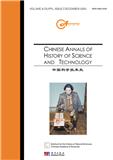
中国科学技术史(英文)(Chinese Annals of History of Science and Technology)(不收版面费) 知网维普万方目次维普目次
- AMI入库
- 国级普刊
- 主管单位:
中国科学院
- 主办单位:
中国科学院自然科学研究所、中国科技出版传媒股份有限公司
- 国际刊号:
:2096-4226
- 国内刊号:
:10-1461/N
- 学科分类:
- 字数:
8000-84000
- 有无基金:
/有基金 100.0%
- 周期:
CN外文-半年刊
- 特殊属性:
外文期刊
- 电话:
010-57552521(202302期)
- 邮箱:
cahst@ihns.ac.cn(202302期)
- 复合因子:
0
- 综合因子:
0
- 收录:
知网,维普,万方目次,维普目次
- 级别:
AMI入库,国级普刊
期刊简介
《中国科学技术史》期刊已被查看: 次
更新频次
单位占比
一作占比
/有基金-100.0%投稿指南
1、投稿方式:在线投稿。
2、刊内网址:(202302期)
https://www.sciengine.com/CAHST
投稿系统:
https://mc03.manuscriptcentral.com/cahst
3、主办单位网址:http://www.ihns.cas.cn/
(中国科学院自然科学史研究所)
4、刊内邮箱:cahst@ihns.ac.cn
5、刊内电话:010-57552521
6、出刊日期:半年刊,每年6月、12月出版。
7、微信公众号:中科院自然科学史研究所(CAS_IHNS)
8、不收取版面费。(刊内投稿须知信息)
2024年4月15日星期一
《中国科学技术史(英文)》投稿须知与体例
(Chinese Annals of History of Science and Technology)
【2023年02期信息】
Instructions for Authors
Aims and Scope
Chinese Annals o f History o f Science and Technology (CAHST) aims at further research on the formation and development of science and technology in China, and will disseminate the communication and interaction on science and technology between China and other parts of the world. CAHST encourages studies with different perspectives and approaches, especially interdisciplinary research and cross-cultural and transnational studies on the history of science and knowledge, including issues of dissemination and transformation that go beyond the Chinese tradition. We hope that CAHST will bring to the international academic community a new understanding of the diversity and global character of science and technology.
CAHST will publish longer research papers and reviews, but also specific studies on original documents and archaeological findings. Book reviews, review essays on previous research, and ongoing discussions and controversies on historiography or methodology are also welcomed. We aim to make each issue of this journal thematic, with more or less homogeneous subject matter.
Submission
Manuscripts should be submitted to the editorial office via email or https://mc03.manuscriptcentral.com/cahst in English or Chinese.
There are no page charges in Chinese Annals o f History o f Science and Technology.
Style Guide
1 Preparation of manuscripts
The manuscript should be prepared with a major word processing program and the file also submitted as a PDF (to clearly indicate all fonts). Please provide the author's affiliation (address and email), an abstract of 150-300 words presenting the main arguments of the paper, 4-8 keywords, high-resolution figures (with permissions), acknowledgments and references.
“Documentation II: Author-Date References” in The Chicago Manual of Style and a back issue of the journal can be used as guides to prepare the manuscript.
2 Structure of the text
The text is divided into several sections and subsections with up to two levels of headings (not capitalized) as follows:
1 Main section
1.1,1.2,1.3 Subsection
Format
The default font of the title, headings, subheadings, and main text body are Book Antiqua 16 pt, 12 pt, 11 pt, and 10 pt, respectively. The abstract, captions, citations, and references are set to Book Antiqua 9 pt. Apart from the first paragraph of each new section, the first line in each paragraph is indented 1.5 ch. The line spacing for all paragraphs is set at 1.2 li. Footnotes, rather than endnotes are used. The indentation of an offset citation is 1.5 ch on both sides, with no indentation on the first line.
Language
The journal uses American English. Authors whose first language is not English may wish to have their manuscripts checked by a native speaker before submission.
Dates
Use the style (September 30, 2016). Write out centuries in full (e.g., "the twentieth century’’); the adjectival form of centuries is hyphenated, e.g., "twentieth-century art." Decades are written as "1960s." If specific periods (e.g., Warring States period), reigns (e.g., the reign of Emperor Kangxi) or dynasties are mentioned, then the specific dates are either placed in parentheses or given in the main text the first time they appear. For instance, "After the end of the Second Opium War in 1860," and "During the Qing dynasty (1616-1911).,/
Abbreviations
Write out in full any abbreviation or acronym that may not be familiar; if it is used again in the text, add the abbreviation in parenthesis at the first occurrence. The following abbreviations nb.r ca., d., fl., and x!' are used for ''born, circa, died, floruit, and reigned," respectively.
Punctuation
An en dash (-), not a hyphen (-), is used to indicate numerical spans (for instance, 618-621 and 1880-1945). An em dash ( —) is used to set off parenthetical statements.
Quotations
An English translation of sources should be provided. The translated text should be followed in the running text by the original source placed in parentheses. If a longer block quotation is used, the original source text should be given in a footnote and enclosed in quotation marks, but not in parentheses or brackets.
Chinese language
The Chinese phonetic alphabet (Pinyin) is employed in the following cases: Chinese people's names, place names, articles or book titles, and specific terms. (The Piny in is written in groups of phrases.) When the aforementioned words appear for the first time, Chinese characters should follow. For later appearances, only the English names are required if there are no similar ones used that may cause confusion. The following formats are adopted when the names, titles, or terms appear for the first time in an article:
Chinese names: Pinyin / Chinese, for example, Xu Guangqi 徐光啟(1562-1633). Chinese publication titles (in running text): English / Pinyin and Chinese in parenthesis, for example, History of Science and Technology in Pre-modern China (ZJwngguo kexue jishu sW中国科学技术史).
Chinese characters: Chinese quotations use traditional or simplified Chinese characters in accordance with the original texts.
Chinese place names: Pinyin / Chinese, for example, Erlitou 二里头•
Chinese quotations: English translation / Chinese quotation in parenthesis, for example, "what is so ingenious about this mechanism"(其造微之妙).
3 References
The journal follows the author-date reference system. The references can be given in a standard reference database and will then be formatted automatically. Otherwise, please follow the reference formatting guidelines below. Full references are listed at the end of the manuscript and the author-date abbreviation given in the main text in parentheses as follows:
• Two authors: (Yang and Li 2005,107)
• Three or more authors: (Yang et al. 2003, chap. 7)
• Multi-authored text by authors with the same surnames: (Yang and Yang 2005, fn. 3)
References are separated by semicolons in a single parenthetical citation, for instance, (Gey 1933; Landecker 2004; Landecker 2007).
The reference list is arranged in alphabetical order according to the authors’ surnames (or Chinese surnames given in Piny in). Documents by the same author are arranged in the order of year of publication. Publications in the same year are sequenced in the order of the initial words of the titles, with a, b, and c added (1963a, 1963b, etc.). Article titles are enclosed in quotation marks, while book or journal titles are written in italics. As for names of Chinese publishers, corresponding official English names are directly adopted, for instance, Science Press. Examples are:
Edited books:
Lu, Jiaxi 卢嘉锡,ed. 1996. Z/ion怒wo fcexwe s/n•中国科学技术史[History of Science and Technology in Pre-modem China]. Beijing: Science Press.
Multivolume books:
Needham, Joseph. 1954. Introductory Orientations. Vol. 1 of Science and Civilisation in China. Cambridge: Cambridge University Press.
Theses and dissertations:
Guo, Jinsong. 2019. ''Knowing Number, Mathematics, Astronomy, and the Changing Culture of Learning in Middle-Period China, 1100-1300./, An unpublished PhD diss., Princeton University.
Articles in books:
Author's last name, author's first name; year; title of article; title of book; editor or translator; page numbers; city and publisher.
Zhu, Zhongyuan 朱重远.2015. "Chang Tsung-sui"张宗燧.In Vol. 2 of £rs/n’ Z/zcmggwo
20 世纪中国知名科学家学术成就概览•物理 学卷[A Brief Review of Chinese Well-Known Scientists' Academic Achievements in the Twentieth Century: Physics], edited by Chen Jia'er 陈佳再,92-105. Beijing: Science Press.
Journal articles:
Author’s last name; author’s first name; year; title of article; periodical; volume; issue; page numbers.
Li, Shu-hua. 1954. ^Origine de la Boussole II. Aimant et Boussole/7 Isis 45 (2): 175-196.
Website:
Name of editor or author (if given); publication date; title; sponsor; date of last update (if any); date of access; URL.
The Nobel Prize Organization. 2015. "Tu Youyou: Nobel Lecture." Accessed May 18, 2019. https://www.nobelprize.org/prizes/medicine/2015/tu/lecture/.
Articles in books (Chinese):
Qian, Baocong 钱宝琮• 1993. swflns/zw 妙wzw s/zw liuchuan Ouzhou kao"《九章算术》
盈不足术流传欧洲考[An Investigation on the Transmission to Europe of the Method for Excess and Deficit in The Nine Chapters on Mathematical Procedures]. In Qian Baocong kexueshi 钱宝琼科学史论文选集[A Selection of Papers by Qian Baocong on the History of Science]: 83-96. Beijing: Science Press.
《中国科学技术史》同类历史期刊
-

隋唐遼宋金元史論叢(隋唐辽宋金元史论丛)(集刊)
集刊-年刊影响因子0
-

史林(不收版面费审稿费)
C刊,北核,AMI核心,武A
CN中文-双月刊影响因子0.73
-

江汉考古(不收版面费审稿费)
C刊,北核,AMI核心,武A-
CN中文-双月刊影响因子1.145
-

史学月刊(原:新史学通讯)(不收版面费)
C刊,北核,科核,武A+,AMI核心,国社科-合格
CN中文-月刊影响因子0.768
-
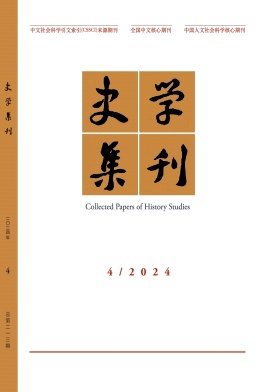
史学集刊
C刊,北核,AMI核心,武A
CN中文-双月刊影响因子0.923
-
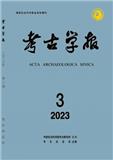
考古学报(不收版面费审稿费)
AMI顶级,C刊,北核,科核,武A+,国社科-合格
CN中文-季刊影响因子2.325
-
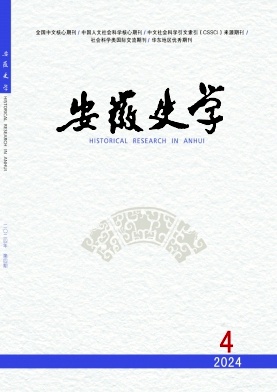
安徽史学(不收版面费审稿费)
C刊,北核,AMI核心,武A
CN中文-双月刊影响因子0.526
-
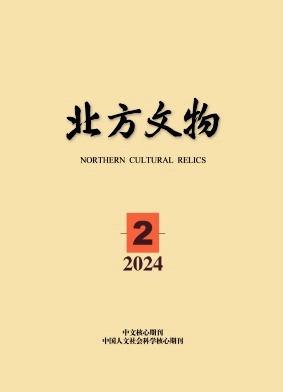
北方文物
北核,AMI扩,武B+
CN中文-双月刊影响因子0.294
常见问题
-
中国科学技术史杂志社官网、联系方式是什么?
中国科学技术史杂志社官网:https://www.sciengine.com/CAHST
投稿网址:https://mc03.manuscriptcentral.com/cahst联系电话:010-57552521(202302期)
投稿邮箱:cahst@ihns.ac.cn(202302期) -
中国科学技术史杂志是核心期刊么?
中国科学技术史是核心期刊,级别是:AMI入库,国级普刊, 是:历史分类下的知网,维普,万方目次,维普目次收录的期刊。
-
请问你们是中国科学技术史杂志社吗?
我们不是《中国科学技术史》杂志社。本站主要从事期刊信息展示与期刊推荐,不是任何杂志官网,直投稿件请联系杂志社。本站仅提供免费的学术指导、论文辅导、期刊投稿信息整理收集服务。
-
你们指导服务后可以保证文章被发表吗?
期刊发表的成功与否,主要取决于文章内容的质量。编辑老师会根据研究领域、创新性等多因素进行考量。我们会帮助您理解期刊的发表要求,助力提升发表几率,从而增加发表的机会。
-
晋级论文能否在报纸上发表?
在学术界,论文的发表往往被视为研究者职业发展的重要一环。晋级论文,即为了获得更高职称或学术地位而撰写的学术论文,通常需在专业期刊上发表。然而,许多人可能会问
